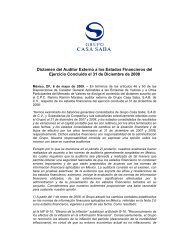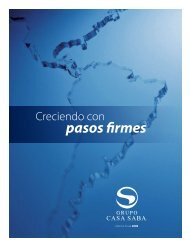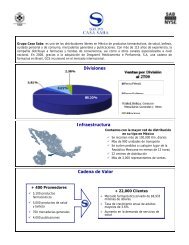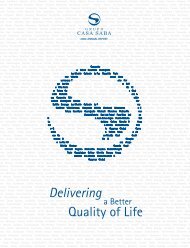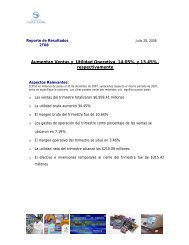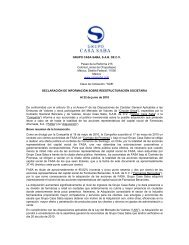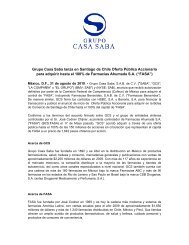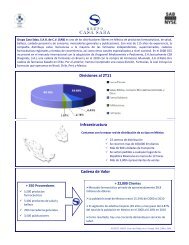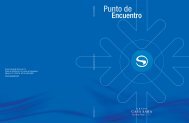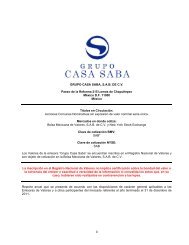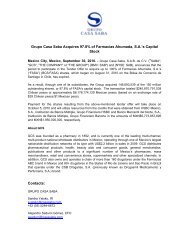FORM 20-F Grupo Casa Saba, S.A.B. de C.V.
FORM 20-F Grupo Casa Saba, S.A.B. de C.V.
FORM 20-F Grupo Casa Saba, S.A.B. de C.V.
Create successful ePaper yourself
Turn your PDF publications into a flip-book with our unique Google optimized e-Paper software.
Table of Contents<br />
In addition, the opening transition asset or obligation is recognized only if a new <strong>de</strong>fined fringe benefits plan is established. Prior services <strong>de</strong>rived from the new plan will be amortized<br />
during the remaining labor life of employees who will receive the benefits. At December 31, <strong>20</strong>11 and <strong>20</strong>10, the Group had not established new benefit plans.<br />
The amount of actuarial gains or losses and the prior service benefits for termination of the employment relationship, due to causes other than restructuring, are recognized in<br />
income. At December 31, <strong>20</strong>11 and <strong>20</strong>10, that amount was immaterial.<br />
Employee profit sharing due is recor<strong>de</strong>d based on the amount payable, <strong>de</strong>termined on taxable income that is obtained as provi<strong>de</strong>d for in the currently enacted tax legislation by applying<br />
a 10 percent rate. Deferred employee profit sharing is <strong>de</strong>termined by using the “asset and liability method”, by applying a 10 percent rate to the temporary differences between book and<br />
tax values of assets and liabilities for employee profit sharing purposes, in accordance with the pertinent legislation. At December 31, <strong>20</strong>11 and <strong>20</strong>10, the <strong>de</strong>ferred employee profit<br />
sharing asset amounted to Ps. 7,107 and Ps. 7,868, respectively. Those amounts were offset by a similar valuation allowance, in accordance with Mexican FRS. Employee profit sharing<br />
is recognized in income in “Other expenses, net”.<br />
r) Income Tax and Corporate Flat Tax (IETU-Spanish acronym)<br />
i) Consolidated taxes on earnings represent the sum of the income tax due and the <strong>de</strong>ferred income tax effect <strong>de</strong>termined by the Company and its subsidiaries, by taking into<br />
account currently enacted tax legislation applicable in the different jurisdictions in which each entity operates. In accordance with currently enacted tax legislation in Mexico, the IETU<br />
Law co-exists with the Income Tax Law for <strong>de</strong>termining the taxes on earnings for the period. Taxes on earnings due in the period are recor<strong>de</strong>d in income.<br />
ii) In or<strong>de</strong>r to recognize the <strong>de</strong>ferred taxes on earnings effect, Management has performed a periodic analysis based on reasonable assumptions to <strong>de</strong>termine the tax base on which<br />
the Group will assess its operations when there is more than one tax base in the same jurisdiction. Pursuant to the foregoing, the Group recognizes <strong>de</strong>ferred taxes on earnings based on<br />
the tax regime that is expected to prevail in the future. At December 31, <strong>20</strong>11 and <strong>20</strong>10, Management <strong>de</strong>termined that income tax will be the tax on earnings that will be paid by the<br />
Mexican entities in the medium-term, instead of IETU. If the Group <strong>de</strong>termines that IETU will be due based on their estimates and that event will qualify as permanent, the <strong>de</strong>ferred<br />
income tax balance will be adjusted to the resulting amount of IETU. If the event is circumstantial, the Group will account for <strong>de</strong>ferred income tax, even though IETU will be due in the<br />
period.<br />
iii) The consolidated <strong>de</strong>ferred income tax effect represents the amount <strong>de</strong>termined by the Company and its subsidiaries by applying the “asset and liability method”. It further<br />
consi<strong>de</strong>rs the tax losses effect and tax credits. Therefore, the <strong>de</strong>ferred income tax liability is recor<strong>de</strong>d for all temporary differences, whereas the <strong>de</strong>ferred income tax asset is only<br />
recor<strong>de</strong>d if it meets the “more likely than not” criteria. The <strong>de</strong>ferred income tax effect is <strong>de</strong>termined by applying tax laws and income tax rates which are enacted or substantially enacted<br />
at the closing date of the financial statements by consi<strong>de</strong>ring the time it is estimated that the temporary differences are realized. In addition, the Group recognizes <strong>de</strong>ferred income tax<br />
generated by its investments in associates. Deferred income tax assets and/or liabilities are classified as a non-current item, regardless of the term in which temporary differences are<br />
expected to be reverse and materialize. Deferred income tax assets and liabilities applicable to different tax jurisdictions are not offset. The <strong>de</strong>ferred income tax effect of the year is<br />
recor<strong>de</strong>d in income as a component of “provisions for income tax”, except for the <strong>de</strong>ferred income tax effect that may be generated by temporary differences attributable to other<br />
stockhol<strong>de</strong>rs’ equity accounts. In that event, the <strong>de</strong>ferred income tax effect is applied to the specific stockhol<strong>de</strong>rs’ equity account that generates it, without being applied to income.<br />
F-29



